Aquatica D20 Housing Overview
[Editor’s Note: Tom & Therisa Stack are Aquatica Dealers]
The enormous popularity of the Canon 20D is well deserved since this camera produces excellent image quality combined with many professional features into an affordable package. We admire the 20D so much, it is our current camera of choice for both commercial and assignment work.
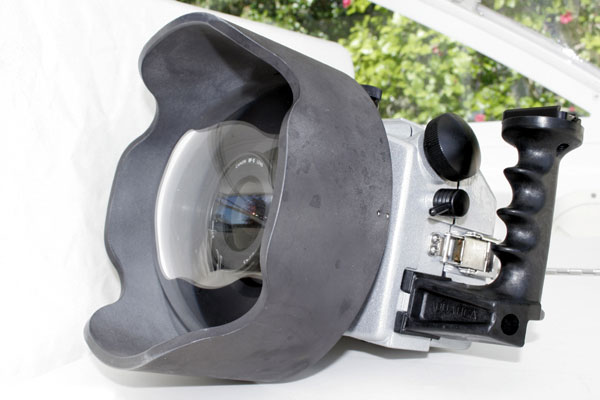
Aquatica A20 housing for Canon 20D with 8” dome port, left side view showing large, easy to use zoom control knob and lens release control underneath.
We’ve used Aquatica housings for over 15 years and as an Aquatica dealer for the past three years we have had the opportunity to use, test and evaluate several cameras and housings through the rapidly changing digital evolutionary process. We have never had any of our Aquatica housings fail us underwater and even our old, rugged, Aquatica Nikon F4s housings continue to serve us well when the need arises to shoot film instead of digital. Aquatica has listened to feedback from us and numerous other professional underwater photographers and as a result their housing for the Canon 20D is a real gem.
The housing is ergonomic, balanced and comfortable to use. The shutter release lever is right where it needs to be, at your fingertip, and features a very short throw distance. Most people will be able to reach the main control dial on the rear of the housing without taking their hands off the right housing handle. The shutter trigger itself is mechanical, which we prefer over an electro-servo connection. We also appreciate an on/off switch on the housing as we’ve used other housings without this feature and it’s not much fun to get down to 40’ and realize you forgot to turn your camera on!
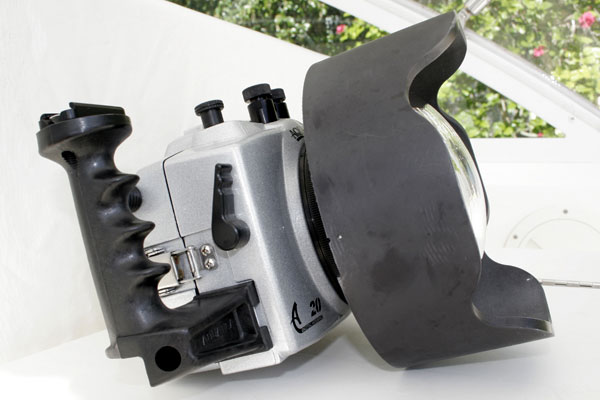
Entire right hand side of Aquatica A20 housing, again showing the excellent position and
size of the shutter release lever.
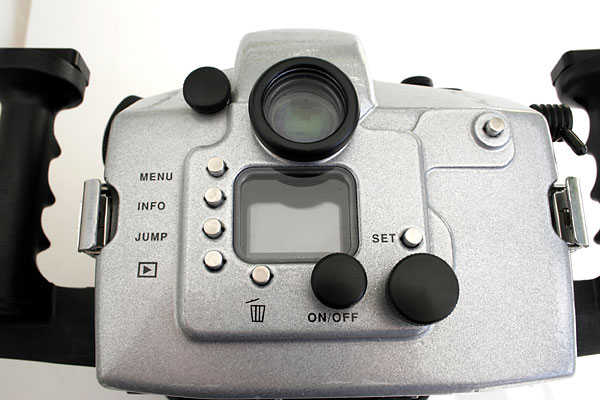
Rear view of the Aquatica A20 housing for Canon 20D showing large, easy to reach and use Quick Control Dial, On/Off dial, viewfinder size and other controls.
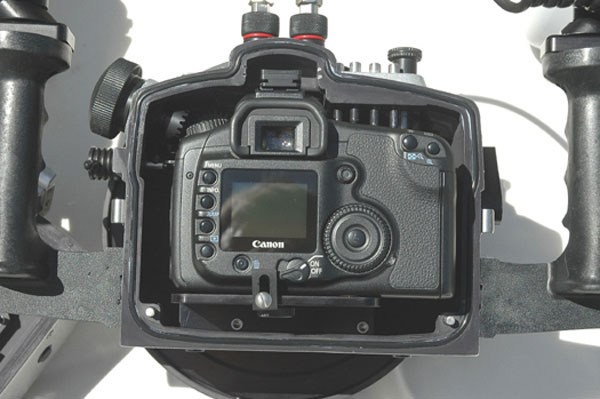
Aquatica A20 housing showing Canon 20D installed. Note the rear swivel bracket on base plate next to camera’s the On/Off switch. In addition to the tripod screw through the bottom of the base plate, this further insures no camera movement for perfect alignment of controls. Large zoom control knob is on top left with large shutter release lever on the right.
We are seeing an increasing number of women in our digital underwater photo workshops and most are concerned about the size and weight of housed cameras. Therisa absolutely loves using this housing, even with dual strobes, she finds it light and compact with minimal drag. We both appreciate the fact that even with an 8 inch dome port this housing remains slightly negative underwater allowing us to use a clip line from a dive boat.
This is a fully functional housing in that each and every control on the camera can be accessed through the housing. If you have properly taken the time to learn and know how to use your Canon 20D, you will find using this housing a joy! The viewfinder is good and we have no trouble composing full frame with the Canon 10-22mm. lens in place.
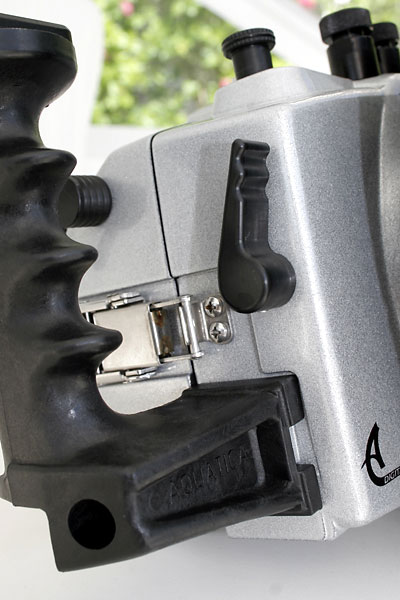
Close up view of Aquatica A20 housing showing the large, ergonomically positioned shutter release lever on the right side of the housing.
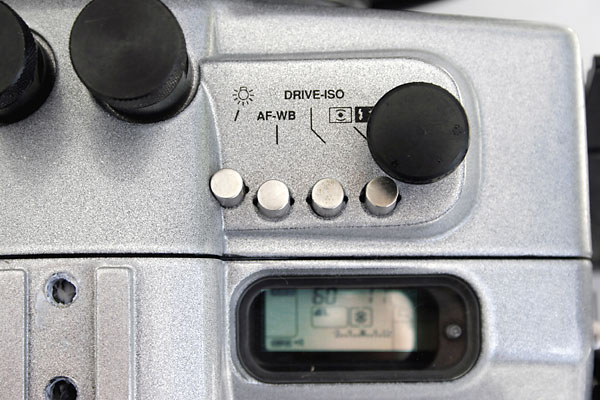
Top right side of Aquatica A20 housing for Canon 20D, showing large, easy to reach Main Control, large, easy to read window for viewing main LCD information panel as well as other controls.
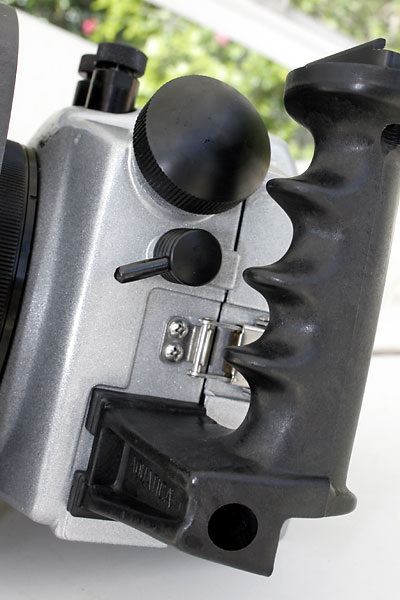
Detailed view of left side of Aquatica A20 housing for Canon 20D showing large, easy to use lens zoom control and lens release lever underneath.
Camera installation is quick and easy. Simply slide the camera onto the base plate while making sure that zoom gear threads mesh, tighten the base plate knob, rotate and tighten a small swivel bracket on the rear of the base plate to further secure the camera in position. Once done all of the controls align with precision and accuracy. Some care needs to be taken to make sure the lens release control lever on the left does not interfere with loading the camera. There are two rubber tabs mounted on the base plate to cushion and protect the camera against vibration. We appreciate that the camera is mounted in the housing rather than on the back plate allowing for quick and easy removal of compact flash cards.
Aquatica now uses sacrificial anodes on all of its current housings. Zinc anodes are installed to protect the housing against salt water corrosion. These anodes are made to deteriorate easier than other strategic parts of the housing, hence the name sacrificial anodes. They can be replaced as needed.
The rear lid is secured by two SS latches with safety locks. It is a bit difficult to close and open these latches without getting your fingers mildly scrunched on the housing handles.
Aquatica’s hot shoe connector is trim and slides on easily but snug enough to ensure a tight, worry free strobe connection.
Some wide diameter lenses will need to be mounted onto the camera through the front port area with the port removed, there is a lens release control on the housing to remove the lens and then the camera.
This housing will use and accept the same, standardized bayonet mount ports and port extenders from all it’s previous digital housings and film housings including the A90, A100 and A5.
Rated to 300 feet and retail priced at $1,999 with dual nikonos strobe bulkheads, we’re loving the affordability and durability of a precision cast aluminum housing.
Photographs, courtesy of Tom & Therisa Stack:
NOTE: Since wide angle shooting is our bread and butter, we have not had a chance to use this housing with either the Canon 60 macro or the Canon 100 macro yet.